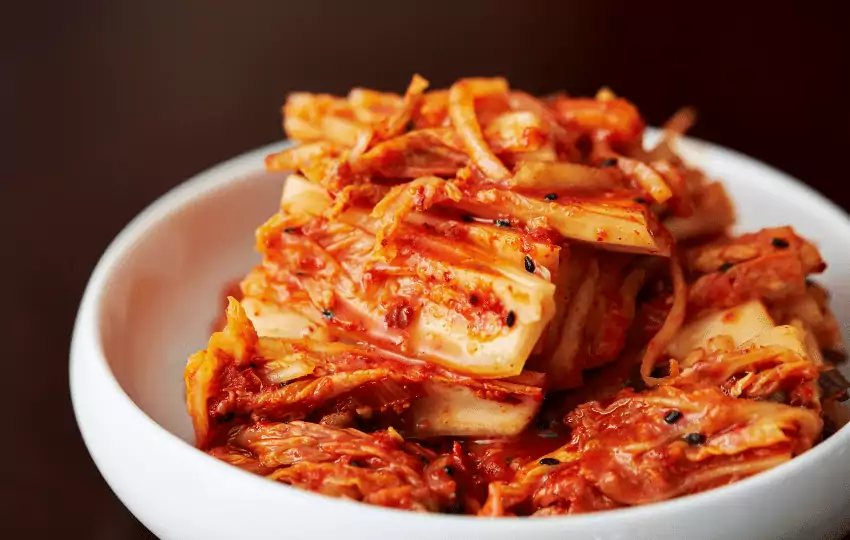As a recipe maker, you know that sometimes you just need a substitution for an ingredient.
For example, what do you do when you don’t have kimchi on hand but want to make a Korean dish?
Don’t worry; we’ve got you covered. Here is a list of substitutes for kimchi that will help you in recipes that call for kimchi and get the same flavors in your dish.
Recommended: Best Paste Substitute for Kimchi Paste
What is Kimchi?
Kimchi is a fabulous Korean dish prepared of fermented vegetables, usually cabbage. Depending on the variety, it can be spicy or mild.
Napa cabbage and Korean radish are pretty similar. Still, the range of seasonings used in making them makes for an endlessly variable dish.
Some common ingredients include gochugaru (Korean chili powder), spring onions, garlic ginger, jeotgal salted seafood, etc.
They both have white outer leaves with green shoots on them, which you can use as your source material when cooking these vegetables.
What does kimchi taste like?
As with all food, it depends on the person’s taste buds. The exact taste can’t be defined.
Some people might describe kimchi as sour and crunchy, while others might say it’s spicy and tangy.
Overall, kimchi is a unique and versatile dish that can be enjoyed in many different ways.
5 Mouthwatering Substitutes for kimchi
There are many kimchi substitutes that can replace kimchi in recipes.
Some popular substitutes include sauerkraut, pickled beets, and pickles.
Each of these substitutes has a slightly different flavor and texture than kimchi, so you may need to experiment to find the one that best fits your needs.
1. SAUERKRAUT- Best substitute for Kimchi
If you’re looking for a substitute with a similar flavor to kimchi, sauerkraut is a good option.
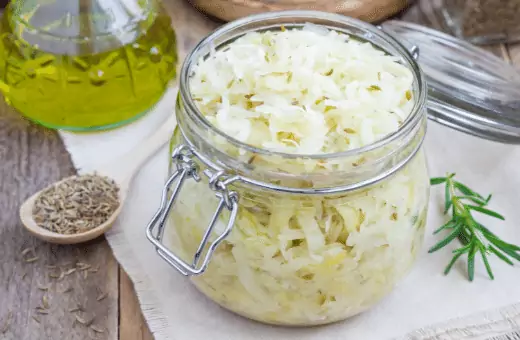
Sauerkraut is made from fermented cabbage, which has a similar sour flavor to the kimchi. It also has a slightly crunchy texture, which can add some variety to your dish.
Sauerkraut is a type of fermented cabbage that is made by mixing chopped cabbage with salt.
The mixture is then left to ferment for a few weeks. The cabbage will release lactic acid during this time, which gives sauerkraut its characteristic sour taste.
It’s important not to wash cabbage before making sauerkraut because doing so will wash away the beneficial lactic acid bacteria from the surface of the cabbage leaves. This means your kraut won’t ferment properly.
You can wash your hands well with soap under running water to remove any harmful bacteria that might be present on your hands.
Read More- What’s the difference between Kimchi and Sauerkraut
The cabbage for sauerkraut is typically cut into thin strips called ‘chips.’
Slice the cabbage as thinly as possible using a sharp knife to ensure they ferment properly.
Don’t use any of the outer leaves of the cabbage because they are likely to make your Ssauerkraut bitter.
Some people suggest adding carrots or apples to sweeten it up a bit; others recommend adding garlic or peppercorns.
Experiment with different flavors until you find something that you enjoy.
Sauerkraut is most commonly eaten raw; simply serve it with meals like any other side dish. It can also be cooked or even mixed into a smoothie.
Read More- Easy Umeboshi Paste Substitutes
2. Use Pickled Beet – A crunchy Alternative for Kimchi
If you’re looking for a substitute that has a similar texture to kimchi, pickled beets are a good option. Pickled beets are a popular way to enjoy the sweet, earthy flavor of beets.
Pickled beets have a similar crunch to kimchi and share some of the same flavorings, such as garlic and ginger.
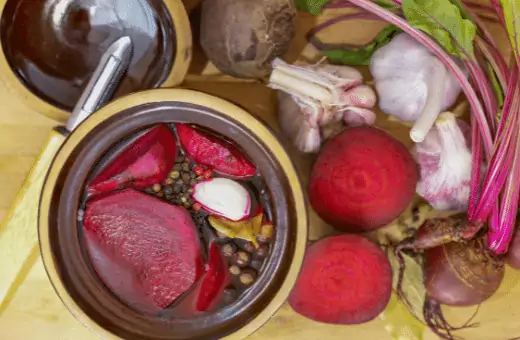
However, pickled beets are not as spicy as kimchi, so they may not be a good fit for all recipes.
Pickled beets are made from cooked and then pickled beets, so they have a firm texture similar to kimchi.
Pickled beets can be eaten as a side dish or added to salads. They also make an excellent addition to sandwiches or wraps.
They also have a slightly sour flavor, which will help replicate the kimchi taste.
Use OI-SOBAGI (cucumber kimchi) instead of Kimchi; Give your Dish into Another Kick.
Cucumber kimchi (oi sobagi,) is a type of kimchi made with cucumbers and radish.
It’s normal for non-Koreans to call it “cucumber kimchi” because Korea has other types of pickled vegetables like “kimchi” and “pa-kimchi”.
Although oi sobagi is a type of “kimchi” because it’s not made with gochugaru(red pepper powder), it has a different taste from kimchi. But Can substitute for Kimchi.
Most people consider them similar; you should refer to them as “cucumber kimchi.”
Whether you call it cucumber kimchi or oi sobagi, it’s a delicious way to add some spice to your meals.
It can be consumed as a side food or added to bibimbap or kimchi stew recipes. Give it a try!
3. PICKLES as a Good Replacement for Kimchi
Pickles are a good option if you’re looking for a substitute that doesn’t have a similar flavor or texture to kimchi.
Pickles are made from cucumbers soaked in vinegar and spices, so they have a sour and salty flavor that is different from kimchi.
They also have a crunchy texture, adding some variety to your dish.
4. KKAKDUGI -Cubed Korean Radish Kimchi Alternative
Korean cube radish kimchi is one of the most popular types of kimchi. It is fermented cabbage with a slightly sweet and sour taste.
Korean cube radish kimchi is made with salted napa cabbage, Korean radish, garlic, ginger, and scallions.
The vegetables are shredded and mixed with brine made of salt, rice vinegar, and sugar. The mixture is then packed into a jar or container and left to ferment.
Korean cube radish kimchi has a slightly sour and sweet taste in its early stage of fermentation. As it ferments further, the kimchi will become sourer.
Korean cube radish kimchi can be eaten as a side dish or added to other dishes like soups and stews. It is also a popular ingredient in Korean cuisine.
5. MISO PASTE as The Kimchi Substitute
Another option is to use miso paste, which can be found at most health food stores or Asian markets.
Because it’s fermented and contains healthy bacteria, miso paste has a tangy taste that you can use as a kimchi substitute.
Miso paste can be seasoned with sugar and vinegar to create a quick kimchi recipe.
Ultimately, the best kimchi substitute for you will depend on your preferences and what you are looking for in a dish.
Try out different substitutes until you find one that you love.
6. Homemade Kimchi Substitute
Homemade kimchi is a flavorful and tangy Korean fermented vegetable dish. While there are numerous variations of kimchi, the following is a basic recipe to get you started:
Ingredients:
- 1 medium Napa cabbage
- 1 tablespoon salt
- 1 tablespoon grated ginger
- 3 cloves garlic, minced
- 1 tablespoon Korean chili flakes (gochugaru)
- 1 teaspoon sugar
- 2 green onions, chopped
- 1 medium carrot, julienned
- Optional: radishes, daikon, or other vegetables of your choice
Instructions:
- Cut the Napa cabbage into quarters lengthwise and remove the core. Cut each quarter into bite-sized pieces.
- Place the cabbage in a large bowl and sprinkle salt over it. Massage the salt into the cabbage leaves to help them wilt. Let it sit for about 1 hour, flipping occasionally.
- Rinse the cabbage under cold water to remove excess salt. Drain well and set aside.
- In a separate bowl, combine grated ginger, minced garlic, Korean chili flakes, and sugar. Mix well to create a paste-like consistency.
- Add the green onions and carrot to the paste, along with any other vegetables you’re using. Toss to coat the vegetables with the paste.
- Add the cabbage to the bowl with the paste and vegetable mixture. Using your hands (wearing gloves if preferred), massage the cabbage and vegetables, ensuring they are thoroughly coated with the paste.
- Transfer the kimchi to a clean glass jar or fermentation container, pressing it down to remove air pockets. Leave some space at the top as the kimchi may expand during fermentation.
- Cover the jar loosely with a lid or plastic wrap. Allow it to ferment at room temperature for 2 to 5 days, depending on your desired level of fermentation. Remember to burp the jar daily to release any built-up gases.
- Once the kimchi reaches your preferred level of tanginess and fermentation, transfer it to the refrigerator to slow down the fermentation process.
- Homemade kimchi can be enjoyed immediately, but its flavor will continue to develop over time.
Note: It’s important to ensure all utensils, jars, and hands used in the process are clean to avoid introducing unwanted bacteria during fermentation. Additionally, adjust the spice level and seasoning to your preference.
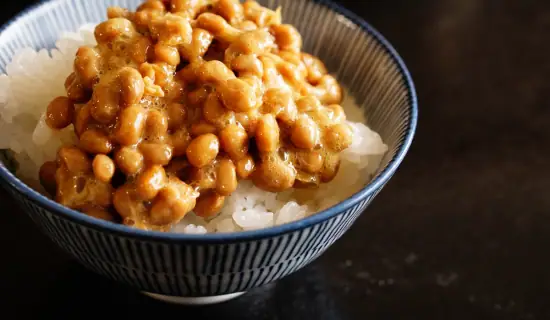
7. Natto
If you’re a fan of Korean cuisine, then you probably already know about the tangy goodness of kimchi. But if you’re looking for a new and exciting way to switch up your taste buds, why not try substituting natto for kimchi?
That’s where natto comes in – this Japanese fermented soybean dish is packed full of flavor and health benefits that will have you coming back for more.
Not only does it add a unique umami taste to any dish, but its slimy texture makes it the perfect addition to sushi rolls or as a topping on rice bowls.
And if you’re worried about the smell, don’t be – once you get past the initial shock, you’ll find yourself craving that distinct aroma.
So why settle for boring old kimchi when you can switch things up with the dynamic flavors of natto? Give it a try and see what all the fuss is about!
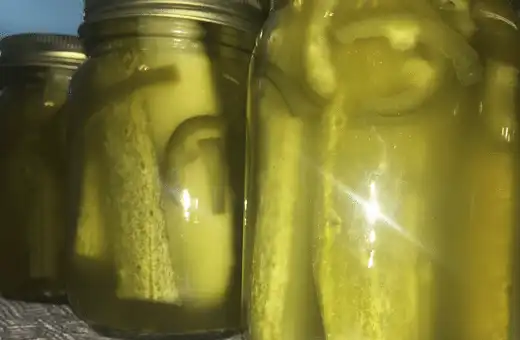
8. Pickle Jalapeños
These fiery little peppers pack a punch of flavor that will wake up your taste buds and bring new life to any meal.
Whether you’re making Korean BBQ, ramen, or even just a simple rice bowl, substitute for kimchi with these pickled jalapeños will give your dish an exciting twist. The crisp texture and tangy taste of the jalapeños pair perfectly with the spicy kick that we all know and love from kimchi.
The best part? They offer all of the flavor and zing that you love about kimchi without any of fuss or preparation time.
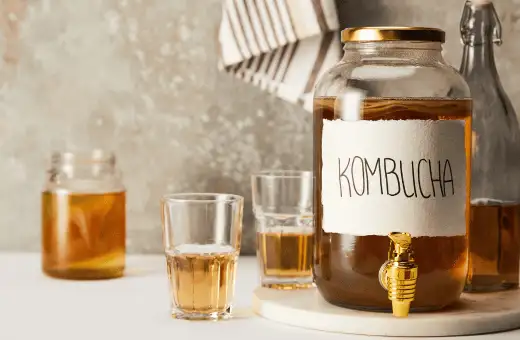
9. Fermented Drinks Like Kombucha
Looking for a substitute for kimchi that’s not only healthy but equally tasty? Look no further than fermented drinks like Kombucha!
With its naturally occurring probiotics and enzymes, Kombucha is the perfect substitute for kimchi, providing you with all the gut-friendly benefits of this Korean staple.
it comes in a variety of flavors to suit any palate – from sweet and fruity to tangy and tart. So why settle for just one flavor when you can have them all?
Whether you’re looking to add some zing to your salads or give your morning smoothie a boost, Kombucha is the way to go!
How long does kimchi last after opening?
Kimchi lasts for 7 days to 2 months after it is opened.
Once opened, kimchi should be kept in the refrigerator between 0 degrees Celsius and 4 degrees Celsius.
Moreover, it can last without quality change up to two months if you freeze it at -18 degrees Celsius or below within six hours of opening.
Kimchi that is not stored in the fridge or frozen may start to rot, so it is essential to always check for any signs of spoilage.
If you are wondering how to store kimchi, you should keep a few things in mind.
First, make sure to keep kimchi away from other food items, as it can contaminate them with its strong odor.
Additionally, do not let kimchi come into contact with water, as it will make the vegetables soggy and unpalatable.
Last but not least, always use a clean utensil when scooping kimchi from the container to avoid contamination.
With a little bit of care, you can enjoy your kimchi for a long time.
Does kimchi have onions?
Yes, kimchi typically contains onions. However, there are variations of kimchi that do not contain onions.
For instance, some versions of white kimchi do not contain any onions.
Additionally, there are also vegan versions of kimchi that do not contain onions.
So, the answer to this question really depends on the type of kimchi you are asking about.
What is similar to kimchi?
There are many similar foods to kimchi, including sauerkraut, pickles, and various types of fermented vegetables.
All of these foods are made by fermenting vegetables in a salty brine or vinegar solution. This process preserves the vegetables and gives them a sour, tangy flavor.
Read More- Best Alternatives for Korean Red Chili Paste ( Gochujang)
My Favourite Replacements for Kimchi
- Pickle
- Sauerkraut
- Miso Paste
Wrap Up On- Kimchi Substitute
If you’re looking for a kimchi substitute, there are a few options you can try. One easy option is to use sauerkraut.
Sauerkraut is prepared from fermented cabbage, and it has a similar flavor to the kimchi. You can also use store-bought pickled cucumbers or beets to add a similar flavor.
No matter what kimchi alternate you choose, you’ll be adding a delicious, tangy flavor to your meals.
So why not give one of these substitutes a try? You may discover that you prefer them over traditional kimchi!
FAQs- Related to Kimchi & Its Alternatives
Q1. Can I substitute cabbage for kimchi?
Yes, you can substitute kimchi with cabbage as long as the flavor of the original kimchi is not lost.
For example, if you use gochujang (hot pepper paste) to make kimchi and want to use cabbage as a substitute, add some gochujang to it before serving.
Q2. Are kimchi and pickled are same?
No. They are different.
Pickled food means that the vegetables or fruits were soaked in a vinegar or brine solution. There are many types of pickled food, but the most popular one is cucumber pickles.
Kimchi is fermented where microorganisms, such as bacteria or yeast, convert the natural sugars in food into lactic acid or alcohol.
This process makes the food more acidic and also makes it taste sour. Fermentation also preserves the food, lasting for a long time without going bad.
Q3. Which came first kimchi or sauerkraut?
There is no clear-cut explanation to this question, as kimchi and sauerkraut are ancient dishes.
However, sauerkraut is thought to have originated in Germany around the 4th century AD. In contrast, kimchi is thought to have originated in Korea sometime between the 7th and 10th centuries AD.
So, kimchi is a little older than sauerkraut, but both dishes are ancient and have a long history.
They are both popular in their respective countries (Germany and Korea) and are considered national dishes.
So, whichever one you prefer, you can’t go wrong!
Q4. Is kimchi pickled or fermented?
Kimchi is fermented. Pickling is one of the methods of preserving vegetables and fruits these days, but it’s not fermented like kimchi.
During fermentation, microorganisms convert natural sugars in food into lactic acid or alcohol.
This process makes the food more acidic and preserves it for a long time without going bad.
Pickles are not fermented, which is why they don’t have the same sour taste that kimchi has, and they’re also not as acidic.

